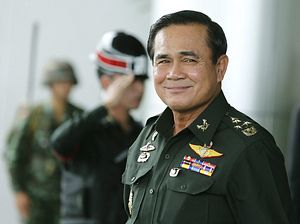On June 14, Thai media outlets reported that the cabinet had approved the Royal Thai Army (RTA) proposal to buy 34 armored personnel carriers from China. Though this represents the confirmation of a move that had been mulled earlier, it nonetheless signifies Bangkok’s insistence on moving forward with Beijing on the defense side in spite of lingering concerns in some circles about what it means for the Southeast Asian state.
As I have noted previously, military cooperation between China and Thailand, the oldest U.S. ally in Asia, has deepened somewhat in the past few years amid an initial downturn in U.S.-Thai relations over rights concerns following the May 2014 coup (See: “China, Thailand Eye Deeper Defense Ties”). Though much of the focus has been on submarines, there have been other notable developments as well, including a first-ever joint air force exercise, planned purchases of tanks, and even discussions about a joint military production facility to advance defense industry cooperation (See: “China, Thailand Mull Joint Military Production Facility”).
Given a variety of factors, including the new nature of the Sino-Thai defense relationship as well as budgetary constraints on the Thai side, close observers of the Southeast Asian defense space have paid close attention to the progress of some of these transactions to see if they are indeed moving forward as planned. And so far, a number of them look to be in 2017 despite some controversy, such as tanks and submarines (See: “Did Thailand Secretly Approve Its China Submarine Buy?”).
On Wednesday, local media outlets reported that the Cabinet had approved the RTA’s request to buy 34 ZBL-O9 VN-1 armored personnel carriers (APCs) from China for 2.3 billion baht. The Cabinet gave the nod with budgetary commitments for fiscal years 2017 out to 2020, and Thailand’s military chief Chalermchai Sitthisart said that a Thai official would travel to China this month or next to sign the contract.
Though no additional details were provided, the development appears to be follow-up work from an earlier announcement by the RTA about an APC deal with China. Back in April, the RTA had announced during the Langkawi international Maritime and Aerospace Exhibition (LIMA) in Malaysia that it had decided to order 34 ZBL-09 8 x 8 wheeled APCs and 12,506 units of 30mm rounds from China North Industries Corporation (NORINCO), picking this over the BTR-4 APC produced by Kharkov Morozov Design Bureau in Ukraine.
While the first order was for 34 vehicles, additional ones were also expected to be procured in the future. At the time, the move had made headlines because Thailand would be just the second country to receive the exported Chinese APCs after Venezuela.
When questioned about the purchase, Chalermchai told reporters that the deal was merely the consequence of the fact that China had offered a better price, relative to others like Russia or Ukraine, adding that the most important factors were “suitability for the needs of Thailand and the price.” “Buying from the West is a little hard…buying from China is better value for money,” he added.
Yet the Thai government’s recent rush to make inroads on a few Chinese deal ahead of Thai Prime Minister Prayuth Chan-o-cha’s planned September visit to China for the BRICS summit in Xiamen has not been lost on observers. For instance, on Tuesday, reports surfaced that Thai Prime Minister Prayut Chan-o-cha had threatened to use Article 44, a special security measure, to push through a railway project that has been met with repeated delays.
Prayut is also expected to travel to the United States to meet U.S. President Donald Trump in late July, the first time Thailand’s military junta chief will be granted a White House visit since taking power following a bloodless coup in May 2014. He was one of three Southeast Asian leaders who were invited to the White House by Trump back on April 30, with the others being Singapore Prime Minister Lee Hsien Loong and Philippine President Rodrigo Duterte.
































